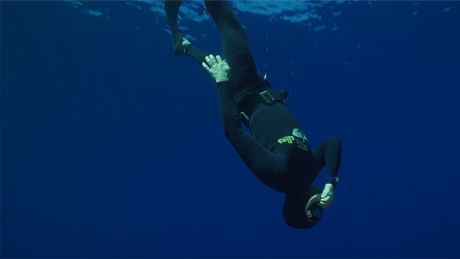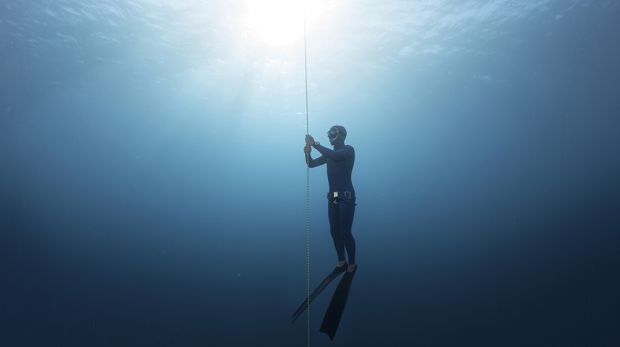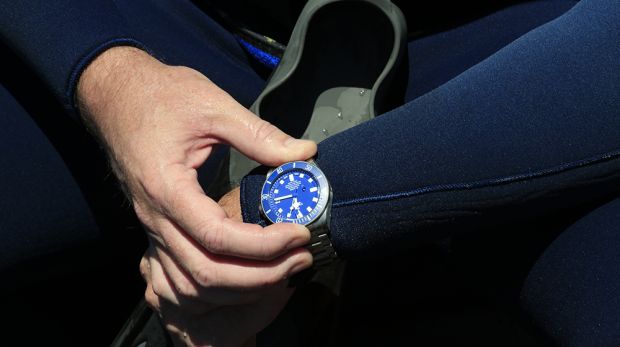Freediving into the Abyss
Coach dives into the Atlantic ocean for a crash-course in freediving. Take a deep breath…

Everybody knows what scuba diving is: you squeeze into a wetsuit, put some flippers on, strap nitrogen and oxygen to your back and swim into the abyss, dodging sharks and the like. But what if you remove the air tank? Well, that’s essentially what freediving is.
There are a number of disciplines available, but when Tudor Watches took Coach to Tenerife to try it out, constant weight freediving was the preferred practice. A typical constant weight session involves the diver stating the distance to which they want to dive, before a weighted guideline is dangled into the deep to the predicted depth.
It’s the diver’s job to descend into the blue, swim parallel to the line, grab a tag at the bottom to prove they reached the depth, and return to the surface, all on a single breath. There are no back-up tanks or fail-safes; you’re on your own, with only your rapidly deflating lungs for company.
Practice is usually carried out in a swimming pool – the more regularly you practice apnea (holding your breath), the more air your lungs will be capable of accommodating over time. Unfortunately, Coach only had enough time for a quick 30-minute session before it was out onto the high seas. As we boarded the speedboat and bounced into the picturesque Tenerife bay, led by world champion freediver Morgan Bourc’his, the beautiful scenery and endless, tranquil ocean betrayed the difficulty that was about to greet us.
For Coach, the first few dives proved extremely stressful, with the panic literally bubbling under the surface the entire time. At first, just the feeling of being upside down in the sea is enough to push the hysteria button, and early attempts were all of the sub-five metres variety.
There’s also the matter of equalisation. As you dive downwards, pressure builds up in your ear canal and – if left to increase – can potentially tear your eardrum. It’s necessary to equalise the pressure: the most common method is to hold your nose while attempting to breathe out of it, in order to pop your ears. It’s an unpleasant feeling, and can lead to extra air-loss if done incorrectly.
A number of things happen to the body during a freedive – the heart rate drops, then blood is sent urgently to your main organs, particularly the lungs, to stop them from collapsing (at dives of over 100m, the lungs can shrink to the size of oranges). Your temperature also cools and your brain slows down – it’s possible to enter a sort of meditative state, which is crucial to take your mind off the fact that you’re in the middle of the sea, running out of oxygen.
Get the Coach Newsletter
Sign up for workout ideas, training advice, reviews of the latest gear and more.
The discipline is mental as well as physical. Coach experienced precisely none of that deep thought, particularly during the eventual, officially recorded depth of 16m (17m the day before – unrecorded, annoyingly), which, compared to the constant-weight men’s world record of 128m, is nothing, but it felt like an achievement. Down at that distance, you’re submerged in a world like no other – surrounded by dark blues and silence (apart from the dreadful screech your ears make as you equalise), it’s easy to see why professionals can attain such a sense of calm.
Being unprofessional, however, it’s an oasis of stress and anxiety. Once you begin your ascent that does dissipate somewhat, and contrary to popular belief, there’s also little danger of the bends, because you’re diving entirely on one breath, meaning there’s not enough nitrogen building up in the blood to cause any damage.
Where to Try Freediving
If you want to give it a go, Coach’s recommendation would be Apnea Canarias Freediving Center in Tenerife, which is recognised as one of the best deep diving spots in the world. Two-day courses run from €290.
There are also freediving sites in the UK; see britishfreediving.org for details.
Coach flew with easyJet; Gatwick to Tenerife South, prices from £65 return, and stayed at the Iberostar Grand Hotel Mencey, rooms from £37 per person.
The Main Freediving Disciplines

Static apnea The diver simply holds their breath for as long as possible, usually in a swimming pool.
Dynamic freediving The diver holds their breath in a pool while swimming and their furthest horizontal distance is measured.
Free immersion The diver uses a line to drag themselves vertically through the descent and ascent. No swimming is involved.
Constant weight The diver does not touch the line, and swims downwards and back again, with or without fins.
Variable weight The diver descends on a heavy weighted sled at great speed, then swims back to the surface.
No limits The diver descends with a sled, then is pulled upwards at great speed using a buoyancy device. This is the deepest and most dangerous form.
The Tudor Pelagos

For any freediver, a sturdy watch is essential – timing is at the very top of the list of priorities. However, due to the pressures of the sport, not just any watch will do: it needs to be up to the task, much like Tudor’s latest diving watch, which is a masterclass in mechanical watchmaking. Not only does it look the business, with a titanium bracelet and ceramic matt blue face, but it also contains a wealth of features that make it one of the best specific diving watches on the market.
Firstly, and most importantly, it’s waterproof to 500m – further than anybody is ever likely to freedive (and for the most part, scuba dive) – and contains a special helium escape valve, designed especially to protect it from overpressure during deep dives.
The face and hands are also glow-in-the-dark, which is particularly handy once you reach levels absent of light. Perhaps the most ingenious feature, however, is the adjustable strap. It can be clipped into a spring-loaded mode, which enables it to fit over a wetsuit, and expand and contract as the neoprene on the suit does at different depths. tudorwatch.com
Gary Ogden wrote for the print edition of Coach between 2015 and 2016, writing features, interviewing celebrities and covering entertainment. He has also written for ShortList.
